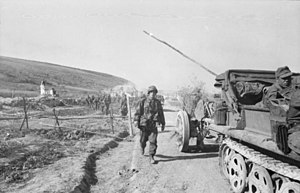| Operation Citadel | |||||||||
|---|---|---|---|---|---|---|---|---|---|
| Part of the Battle of Kursk on the Eastern Front of World War II | |||||||||
 German Sd.Kfz. 10 half-track towing a gun during the operation | |||||||||
| |||||||||
| Belligerents | |||||||||
|
|
| ||||||||
| Commanders and leaders | |||||||||
| Strength | |||||||||
| Casualties and losses | |||||||||
Operation Citadel (German: Unternehmen Zitadelle) was the German offensive operation in July 1943 against Soviet forces in the Kursk salient, proposed by Generalfeldmarschall Erich von Manstein during the Second World War on the Eastern Front that initiated the Battle of Kursk. The deliberate defensive operation that the Soviets implemented to repel the German offensive is referred to as the Kursk Strategic Defensive Operation. The German offensive was countered by two Soviet counter-offensives, Operation Polkovodets Rumyantsev (Russian: Полководец Румянцев) and Operation Kutuzov (Russian: Кутузов). For the Germans, the battle was the final strategic offensive that they were able to launch on the Eastern Front. As the Allied invasion of Sicily began, Adolf Hitler was forced to divert troops training in France to meet the Allied threats in the Mediterranean, rather than use them as a strategic reserve for the Eastern Front.[19] Germany's extensive loss of men and tanks during the operations ensured that the victorious Soviet Red Army enjoyed the strategic initiative for the remainder of the war.
The Germans hoped to weaken the Soviet offensive potential for the summer of 1943 by cutting off a large number of forces that they anticipated would be in the Kursk salient.[20] The Kursk salient or bulge was 250 kilometres (160 mi) long from north to south and 160 kilometres (99 mi) from east to west.[21] The plan envisioned an envelopment by a pair of pincers breaking through the northern and southern flanks of the salient.[22] Hitler believed that a victory here would reassert German strength and improve his prestige with his allies, who were considering withdrawing from the war.[23] It was also hoped that large numbers of Soviet prisoners would be captured to be used as slave labour in the German armaments industry.[24]
The Soviet government had foreknowledge of the German intentions, provided in part by the British intelligence services, the intelligence transmitted by the Lucy spy ring, and Tunny intercepts. Aware months in advance that the attack would fall on the neck of the Kursk salient, the Soviets built a defence in depth designed to wear down the German armoured spearhead.[25] The Germans delayed the offensive while they tried to build up their forces and waited for new weapons, mainly the new Panther tank but also larger numbers of the Tiger heavy tank.[26][27][28] This gave the Red Army time to construct a series of deep defensive belts. The defensive preparations included minefields, fortifications, artillery fire zones and anti-tank strong points, which extended approximately 300 km (190 mi) in depth.[29] Soviet mobile formations were moved out of the salient and a large reserve force was formed for strategic counter-offensives.[30]
- ^ a b c Beevor 2012, p. 485.
- ^ a b Glantz & House 2004, p. 338.
- ^ a b Glantz & House 1995, p. 165.
- ^ a b Glantz & House 2004, p. 337.
- ^ a b c Frieser 2007, p. 154.
- ^ Glantz & House 2004, p. 276.
- ^ Bauman 1998, pp. 5–15.
- ^ Armoured Warfare: A Military, Political and Global History. Alaric Searle
- ^ Clark 2012, p. 408.
- ^ "Heeresarzt 10-Day Casualty Reports per Army/Army Group, 1943" Archived 25 May 2013 at the Wayback Machine. World War II Stats. Retrieved 4 July 2015.
- ^ Bergström 2008, p. 120.
- ^ Krivosheev 2001, p. Kursk.
- ^ Krivosheev 2001, p. Weapons and military equipment. Production and loss.
- ^ a b Frieser 2007, p. 150.
- ^ a b c Krivosheev 2001.
- ^ G.A. Koltunov and B.G Solotiev, (Kurskaya Bitva, p. 366 16-ya Vozdusnye Sily v Volykoy Otechestvennoy Voyne p. 186).
- ^ Krivosheev 1997, pp. 132–134.
- ^ Krivosheev 1997, p. 262.
- ^ Dunn 1997, p. 191.
- ^ Glantz & Orenstein 1999, p. 1.
- ^ Glantz & House 1995, p. 157.
- ^ Nipe 2011, p. 6.
- ^ Healy 2010, p. 42.
- ^ Healy 2010, p. 90.
- ^ Healy 2010, p. 65.
- ^ Newton 2002, p. 12.
- ^ Dunn 1997, p. 94.
- ^ Kasdorf 2000, p. 16.
- ^ Glantz & House 2004, pp. 64–67.
- ^ Glantz 1989, pp. 149–159.
Cite error: There are <ref group=lower-alpha> tags or {{efn}} templates on this page, but the references will not show without a {{reflist|group=lower-alpha}} template or {{notelist}} template (see the help page).